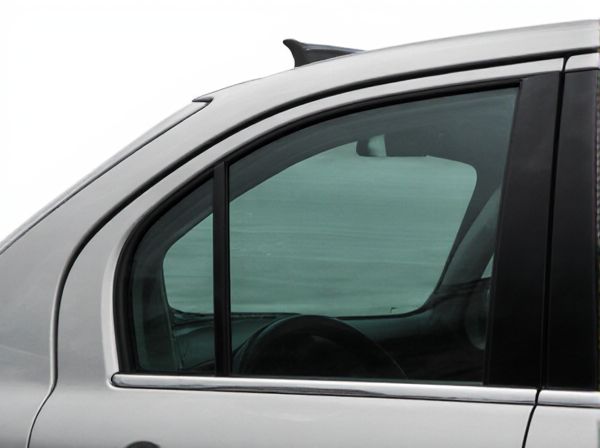
Photo illustration: Laminated Window vs Tempered Window
Laminated windows provide enhanced safety by holding shattered glass together, minimizing the risk of injury from sharp shards. Tempered windows offer superior strength and are designed to break into small, blunt pieces, reducing impact hazards. Choosing between laminated and tempered glass depends on your specific needs for security, durability, and safety in your space.
Table of Comparison
| Feature | Laminated Window | Tempered Window |
|---|---|---|
| Safety | Holds shards together, reduces injury risk | Shatters into small pieces, reduces sharp cuts |
| Durability | Resists penetration, less prone to cracks | Higher tensile strength, resists impact better |
| Sound Insulation | Excellent noise reduction | Moderate noise reduction |
| Security | Difficult to break through | Easier to break compared to laminated |
| Cost | Higher cost | Lower cost |
| Usage | Windshields, front windows | Side and rear windows |
Introduction to Laminated and Tempered Windows
Laminated windows consist of two or more glass layers bonded with an interlayer, providing enhanced safety by holding shards together upon impact. Tempered windows undergo a heat treatment process that significantly increases their strength and causes them to break into small, less harmful pieces. Both types optimize safety and durability but differ in structural composition and impact behavior.
What is a Laminated Window?
A laminated window consists of two or more layers of glass bonded together with an interlayer, typically made of polyvinyl butyral (PVB), which enhances safety and noise reduction. This interlayer holds the glass fragments in place upon impact, preventing shattering and providing increased security compared to regular glass. Laminated windows are commonly used in automotive, architectural, and security applications for their durability and ability to maintain integrity under stress.
What is a Tempered Window?
A tempered window is a type of safety glass processed by controlled thermal or chemical treatments to increase its strength compared to normal glass. When broken, tempered glass shatters into small, blunt pieces that reduce the risk of injury, making it ideal for automotive, architectural, and safety applications. Its enhanced durability and impact resistance distinguish it from laminated windows, which consist of layers bonded by a plastic interlayer to hold shards together upon impact.
Manufacturing Process Comparison
Laminated windows are manufactured by sandwiching a polyvinyl butyral (PVB) interlayer between two glass panes, which are then bonded under heat and pressure to create a single, durable unit. Tempered windows undergo a thermal tempering process where glass is rapidly heated to around 620degC and then quickly cooled to increase its strength through induced compressive stresses on the surface. The lamination process prioritizes safety by holding shattered glass fragments together, while tempering focuses on enhancing the glass's impact resistance and strength through thermal treatment.
Strength and Durability Differences
Laminated windows consist of two or more glass layers bonded with an interlayer, providing enhanced strength by preventing shattering upon impact and maintaining structural integrity even when cracked. Tempered windows undergo a heat treatment process that increases their strength compared to regular glass, making them more resistant to impacts and thermal stress, but they shatter into small, blunt pieces when broken. Laminated glass offers superior safety and durability due to its post-break retention properties, while tempered glass is valued for its impact resistance and controlled breakage pattern.
Safety and Security Considerations
Laminated windows consist of two or more glass layers bonded with an interlayer, which holds the glass shards together upon impact, enhancing safety by reducing the risk of injury and preventing forced entry. Tempered windows undergo heat treatment to increase strength and shatter into small, blunt pieces, minimizing cut hazards but offering less resistance to penetration compared to laminated glass. For security applications, laminated glass is preferred due to its ability to maintain barrier integrity after breakage, while tempered glass is favored in scenarios requiring high strength and impact resistance.
Acoustic and Thermal Performance
Laminated windows provide superior acoustic insulation due to their interlayer that effectively dampens sound vibrations, making them ideal for noise reduction in urban environments. Tempered windows offer enhanced thermal performance through increased strength and heat resistance, but their single glass layer results in less soundproofing compared to laminated glass. For optimal acoustic and thermal efficiency, laminated windows outperform tempered windows by combining sound dampening with moderate thermal resistance.
Cost Analysis: Laminated vs Tempered
Laminated windows generally have a higher upfront cost compared to tempered windows due to their complex manufacturing process involving multiple glass layers bonded with an interlayer for enhanced safety and soundproofing. Tempered windows are more cost-effective initially, as they undergo heat treatment to increase strength but lack the additional sound dampening and UV protection properties of laminated glass. Over time, laminated windows may offer better value through increased durability and reduced replacement frequency, making the cost analysis dependent on specific applications and long-term performance requirements.
Best Applications for Each Window Type
Laminated windows are best suited for areas requiring enhanced security and sound insulation, such as residential homes, schools, and hospitals due to their ability to hold glass shards together upon impact. Tempered windows excel in locations demanding high strength and safety, including commercial buildings, shower enclosures, and vehicle windows, as they shatter into small, less harmful pieces when broken. Choosing between laminated and tempered glass depends on the specific needs for safety, noise reduction, and durability in the installation environment.
Conclusion: Choosing the Right Window
Laminated windows provide superior sound insulation and enhanced security due to their interlayer, making them ideal for areas prone to impact or noise pollution. Tempered windows offer exceptional strength and shatter resistance, suited for applications requiring high durability and safety compliance. Selecting the right window depends on specific needs such as safety, security, soundproofing, and environmental factors.
 caratoz.com
caratoz.com